How to size a residential tankless water heater in 3 easy steps
Properly sizing your tankless water heater maximizes the full potential of your unit, efficiently meeting the full range of household demands.
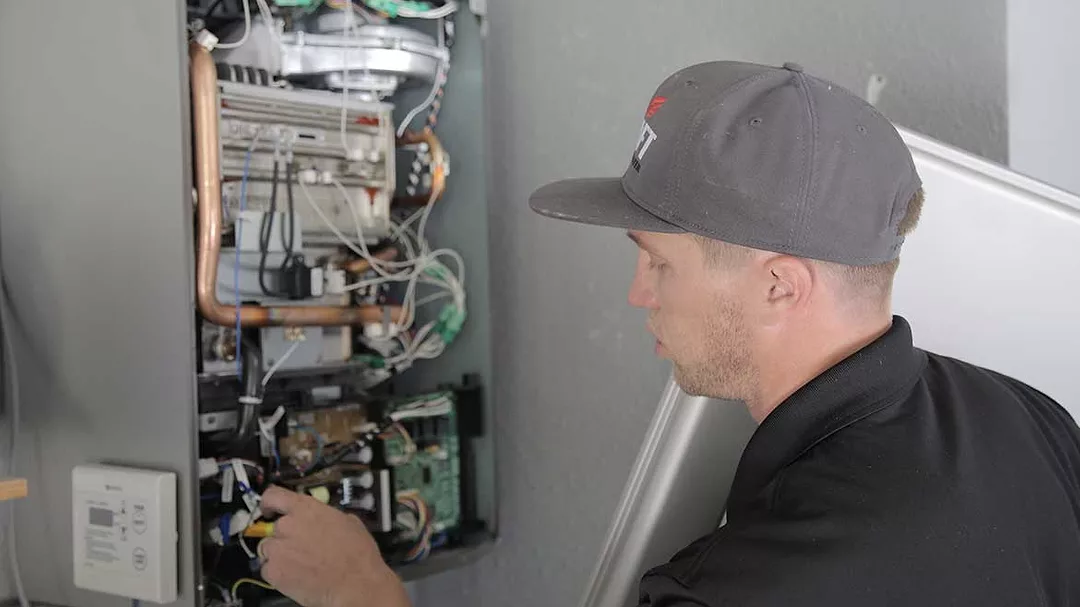
Images courtesy of Noritz America

The tankless unit selected must produce enough hot water for all of the household’s demands, so selecting the appropriately sized model is imperative.
Choosing a new tankless water heater for a home — whether the application is totally new or a replacement — demands a strategic approach that will inevitably impact the efficiency of the owner’s day-to-day routine. The tankless unit selected must produce enough hot water for all of the household’s demands, so selecting the appropriately sized model is imperative.
With tankless water heaters, water is heated on demand, removing the need for storage. If a unit is undersized, water will still warm to the temperature you set during installation; however, as heated water starts to run out, water flow will drop to uncomfortable levels to maintain that set temperature.
In other words, the household will continue to have hot water at the faucet, showerhead, etc. However, lower water pressure creates a hugely negative experience if multiple people live within the household. Only a few fixtures will be available at full flow if the water heater is too small to accommodate the simultaneous use of multiple fixtures.
According to Noritz Service Trainer Will Nourse, this inconvenience is where proper sizing is imperative.
“With an inappropriately sized tankless water heater, users will start to see their water pressure dwindle,” he explains. “It'll appear like water is dribbling out of a faucet or showerhead, etc.”
On the other hand, oversizing a tankless system will not affect functionality. While an undersized unit cannot provide the appropriate amount of hot water if water usage is high, a slightly oversized unit is well equipped to handle it.
The first step in sizing a tankless water heater is to determine the maximum temperature rise, which usually occurs during the coldest days of the year in a locale.
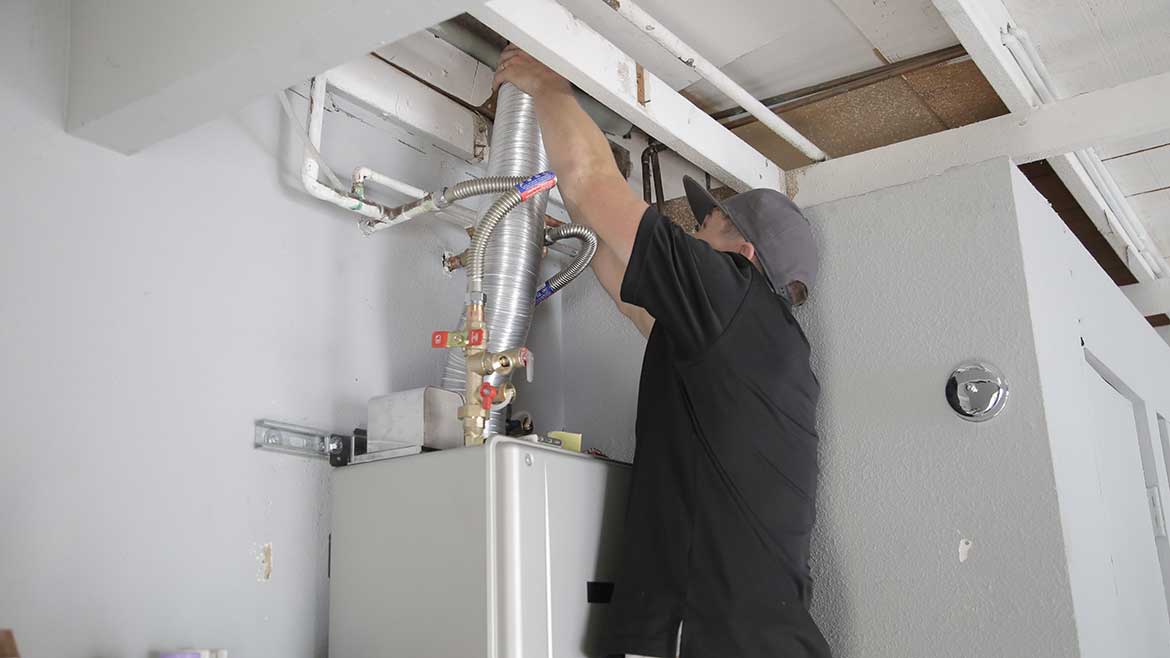
The first step in sizing a tankless water heater is to determine the maximum temperature rise, which usually occurs during the coldest days of the year in a locale.
Of course, a larger unit will likely cost more, but household gas consumption will be the same as if the water heater had been properly sized. This is because, with tankless, gas consumption is based on hot-water demand, not model size. That’s why it's always best to size properly or even slightly oversize to maintain maximum efficiency of the water heater installed.
With tankless water heaters, size refers to the flow rate of the hot water produced, measured in gallons per minute (gpm). This rate will vary, up or down, depending on the temperature difference between the cold water coming into the heater and the hot water it generates. This difference is known as the “temperature rise,” or Delta T.
Determining the correctly sized tankless water heater for a home can be completed with three easy steps.
1. Determine the maximum temperature rise
The first step in sizing a tankless water heater is to determine the maximum temperature rise, which usually occurs during the coldest days of the year in a locale.
Begin with the tankless set temperature. The Consumer Product Safety Commission (CPSC) recommends 120° F as the safest, yet comfortable temperature — a setting that will not scald at the touch.
Next, subtract the wintertime cold-water temperature from this set temperature. Winter groundwater temperature is equal to the mean air temperature above the land surface during the winter months. This temperature varies based on location.
To determine the most accurate wintertime cold water temperature for your locale, you will need to reference a guide to the average winter water temperatures (see Figure 1 below). For example, in North Dakota (located on the Figure 1 map in the purple area), the average winter water temperature ranges from 35° F to 40° F. In Florida (red), it ranges between 65° F to 70° F.
Wintertime cold water temperatures can also vary within a state. In Arizona, average winter water temperatures can range from 45° F to 65° F, depending on location.
FIGURE 1
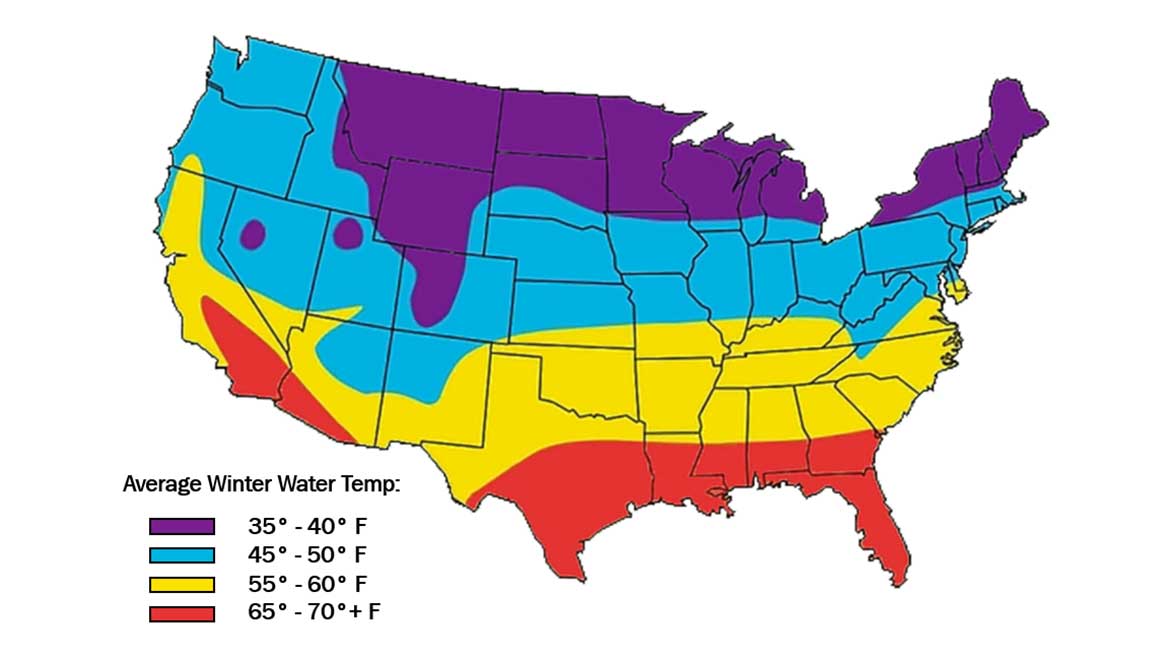
For our purposes, let's use the central coast of California, where the coldest groundwater temperature is 55° F. Following the CPSC recommendation of a set temperature of 120° F and subtracting the wintertime cold water temperature of 55° F calculates as a difference of 65* F. That is your maximum temperature rise.
2. Determine the combined flow rate
Determining the peak hot-water demand of a particular home is the second step. To do so, you must identify the maximum number of hot water fixtures that will consistently be used simultaneously in the home; e.g., first thing in the morning, when everyone is getting ready for work and school.
Keep in mind that product flow rates — again, in gpm — vary among manufacturers. These rates can be found on the fixtures themselves or on the product packaging. Or you can contact manufacturers directly. Note: Average flow rates found online tend to be expressed on the higher side to add a buffer for proper sizing.
The following are typical flow rates for common hot-water appliances in the American home:
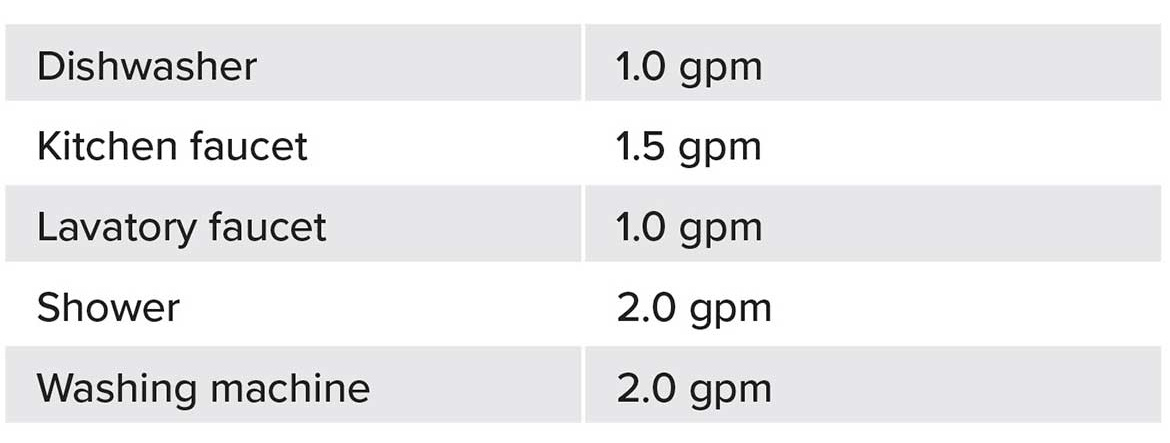
Next, add together the individual flow rates of all the household hot-water outlets that would be used simultaneously. That’s your targeted, peak-usage flow rate: the number of gallons per minute needed at any given time, including the coldest day of winter when the temperature rise — from the cold groundwater to the hot-water outlet — will be at its highest and multiple outlets are in use.
A relatively small peak usage might be two showers and a washing machine, whose flow rates would add up to 6 gpm. A larger household might have a peak usage of four showers and, say, a dishwasher, the sum of whose flow rates are 10 gpm.
3. Select the tankless water heater
The final sizing step is selecting the proper tankless model or models to meet the peak demand. Larger households may require more than one tankless unit.
To make the selection, use a manufacturer’s sizing chart. Typically available online, these charts are also often found in manufacturer product catalogs. The one shown here (in Figure 2), for demonstration purposes, is from Noritz America.
- Listed on the left-hand column of the chart is the maximum temperature rise during the coldest period of the year, ranging from 30° F to 100° F;
- Listed across the top are the different model numbers available, commercial and residential, divided into condensing and non-condensing; and
- The numbers in the columns beneath the model names are their flow rates for the different temperature rises. The colder the climate, the larger the temperature rise, the lower the flow rate.
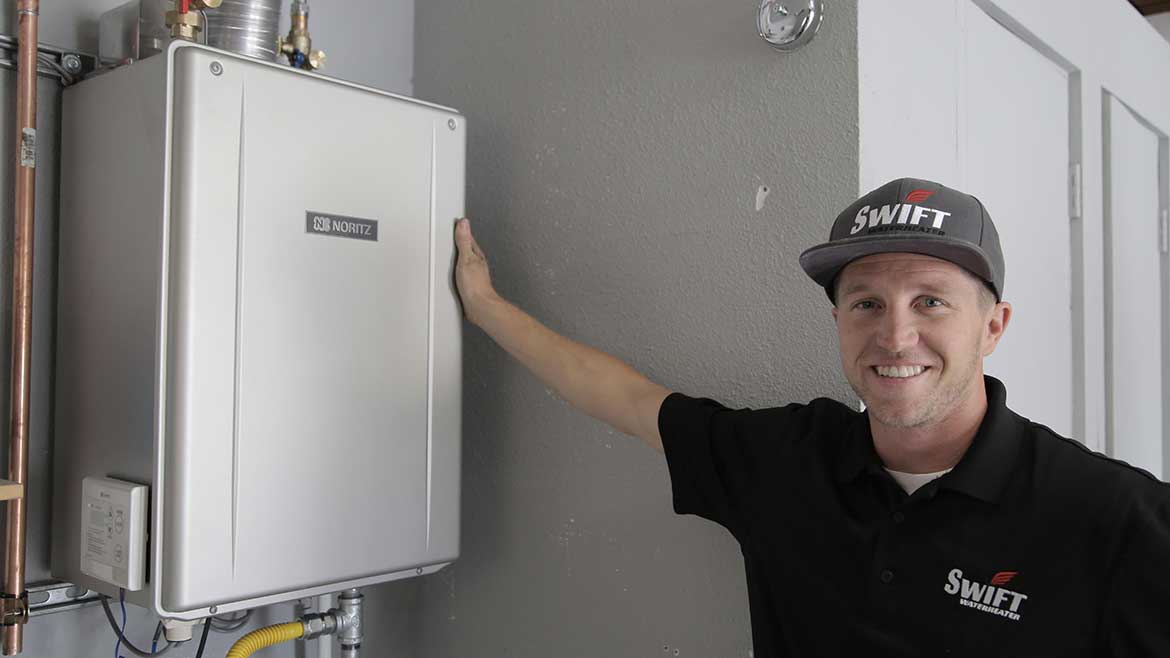
The final sizing step is selecting the proper tankless model or models to meet the peak demand. Larger households may require more than one tankless unit.
The final sizing step is selecting the proper tankless model or models to meet the peak demand. Larger households may require more than one tankless unit.
Next, find the temperature rise that corresponds to your locale. For our California example, again, that would be 65° F.
Then read across to find the flow rates equal to or greater than the combined flow rates of all the hot-water outlets that would be used simultaneously by the household.
For our small-peak usage example, the options would include any model with a flow rate at or above 6 gpm, for which there are several options. For the large peak usage example, we would need to select a pair of tankless models with a combined flow rate at or above 10 gpm.
In either case, those are the tankless water heater models that would meet the combined demand of the simultaneously operating hot-water outlets.
FIGURE 2
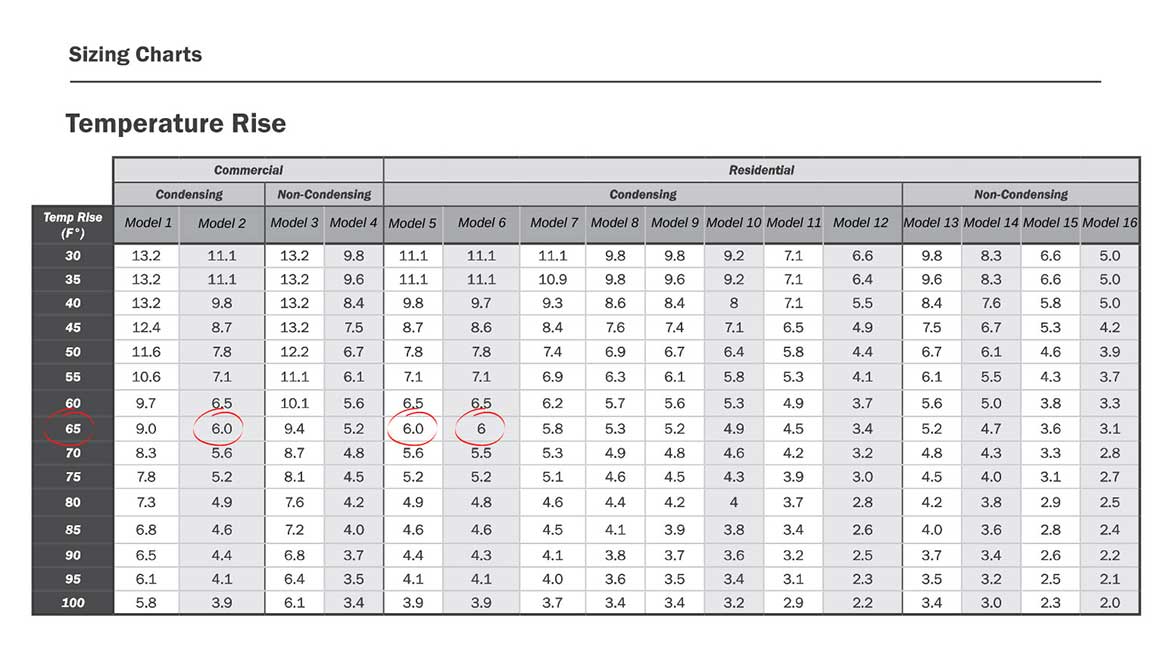
Once again, if you select a tankless solution with a flow rate lower than the peak-usage target, the resulting water pressure is bound to be unsatisfactory (if not downright unpleasant for the unlucky individual taking a shower).
FIGURE 3
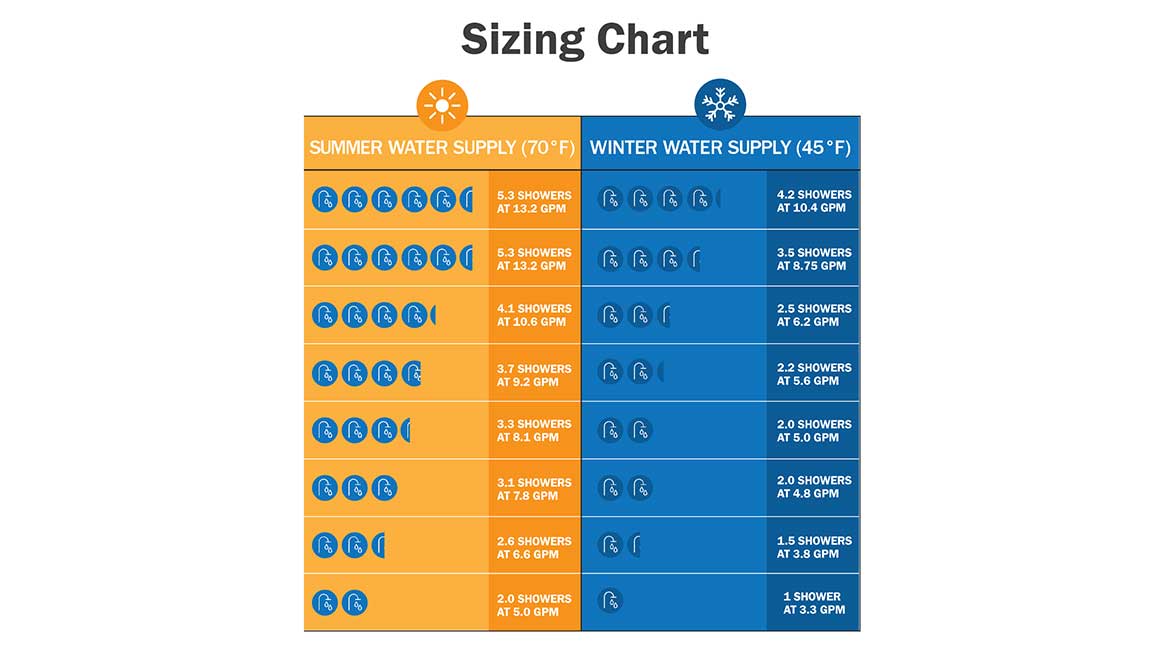
Finding and installing a model whose flow rate will encompass the highest combined demand on even the coldest days should result in a very happy consumer customer.
For more information on proper tankless water heating sizing, please visit www.noritz.com/contact-us.
Looking for a reprint of this article?
From high-res PDFs to custom plaques, order your copy today!






